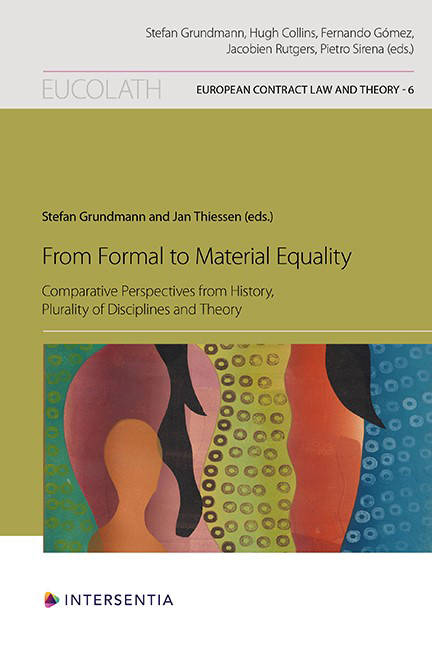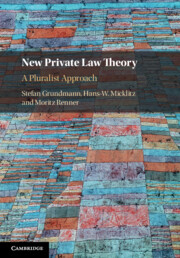71 results
Index
-
- Book:
- From Formal to Material Equality
- Published by:
- Intersentia
- Published online:
- 15 November 2023
- Print publication:
- 12 January 2023, pp 141-146
-
- Chapter
- Export citation
Frontmatter
-
- Book:
- From Formal to Material Equality
- Published by:
- Intersentia
- Published online:
- 15 November 2023
- Print publication:
- 12 January 2023, pp i-iv
-
- Chapter
- Export citation
From Formal to Material Equality: Key Insights from History and in a Multidisciplinary Perspective
-
-
- Book:
- From Formal to Material Equality
- Published by:
- Intersentia
- Published online:
- 15 November 2023
- Print publication:
- 12 January 2023, pp 1-28
-
- Chapter
- Export citation
European Contract Law and Theory Series
-
- Book:
- From Formal to Material Equality
- Published by:
- Intersentia
- Published online:
- 15 November 2023
- Print publication:
- 12 January 2023, pp 147-147
-
- Chapter
- Export citation
Contents
-
- Book:
- From Formal to Material Equality
- Published by:
- Intersentia
- Published online:
- 15 November 2023
- Print publication:
- 12 January 2023, pp v-vi
-
- Chapter
- Export citation
List of Authors
-
- Book:
- From Formal to Material Equality
- Published by:
- Intersentia
- Published online:
- 15 November 2023
- Print publication:
- 12 January 2023, pp vii-viii
-
- Chapter
- Export citation

From Formal to Material Equality
- Comparative Perspectives from History, Plurality of Disciplines and Theory
-
- Published by:
- Intersentia
- Published online:
- 15 November 2023
- Print publication:
- 12 January 2023
New Private Law Theory—A Very Brief Introduction
-
- Journal:
- German Law Journal / Volume 23 / Issue 6 / July 2022
- Published online by Cambridge University Press:
- 25 July 2022, pp. 801-804
-
- Article
-
- You have access
- Open access
- HTML
- Export citation
Part III - Transactions and Risk: Private Law and the Market
-
- Book:
- New Private Law Theory
- Published online:
- 09 April 2021
- Print publication:
- 18 March 2021, pp 205-338
-
- Chapter
- Export citation
Index
-
- Book:
- New Private Law Theory
- Published online:
- 09 April 2021
- Print publication:
- 18 March 2021, pp 517-542
-
- Chapter
- Export citation
11 - Negotiation, the Function of Contract and the ‘Justice of Consensus’
- from Part III - Transactions and Risk: Private Law and the Market
-
-
- Book:
- New Private Law Theory
- Published online:
- 09 April 2021
- Print publication:
- 18 March 2021, pp 207-229
-
- Chapter
- Export citation
Part V - Private Law (Rule-Setting) beyond the State
-
- Book:
- New Private Law Theory
- Published online:
- 09 April 2021
- Print publication:
- 18 March 2021, pp 435-516
-
- Chapter
- Export citation
17 - Between Market and Hierarchy
- from Part III - Transactions and Risk: Private Law and the Market
-
-
- Book:
- New Private Law Theory
- Published online:
- 09 April 2021
- Print publication:
- 18 March 2021, pp 315-338
-
- Chapter
- Export citation
1 - The Inside and the Outside of Law?
- from Part I - Methods and Disciplines
-
-
- Book:
- New Private Law Theory
- Published online:
- 09 April 2021
- Print publication:
- 18 March 2021, pp 35-58
-
- Chapter
- Export citation
21 - The Principal’s Decision
- from Part IV - Persons and Organizations
-
-
- Book:
- New Private Law Theory
- Published online:
- 09 April 2021
- Print publication:
- 18 March 2021, pp 391-413
-
- Chapter
- Export citation
27 - The Shadow of the Law and Social Embeddedness
- from Part V - Private Law (Rule-Setting) beyond the State
-
-
- Book:
- New Private Law Theory
- Published online:
- 09 April 2021
- Print publication:
- 18 March 2021, pp 495-516
-
- Chapter
- Export citation
Preface
-
- Book:
- New Private Law Theory
- Published online:
- 09 April 2021
- Print publication:
- 18 March 2021, pp ix-x
-
- Chapter
- Export citation

New Private Law Theory
- A Pluralist Approach
-
- Published online:
- 09 April 2021
- Print publication:
- 18 March 2021
12 - Knowledge and Information
- from Part III - Transactions and Risk: Private Law and the Market
-
-
- Book:
- New Private Law Theory
- Published online:
- 09 April 2021
- Print publication:
- 18 March 2021, pp 230-247
-
- Chapter
- Export citation
3 - Economics and Private Law Institutions
- from Part I - Methods and Disciplines
-
-
- Book:
- New Private Law Theory
- Published online:
- 09 April 2021
- Print publication:
- 18 March 2021, pp 71-94
-
- Chapter
- Export citation



